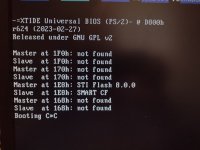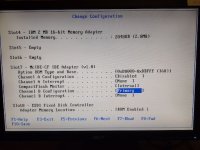MykeLawson
Veteran Member
- Joined
- Mar 20, 2014
- Messages
- 539
Well, it arrived today, I got it installed in the machine, and did all the reference disk voodoo. However, as is usually the case when it comes to something I touch, things are going very slowly. The machine has 6MB of RAM, a dual Async card, and an ESDI controller with one drive (C . I have tried several configurations of the McIDE-CF card, and if there are any cards plugged into it, the Boot Options selection will show stuff, but it just hangs and I can't navigate. If I just let it try to boot normally, it will boot from my C: drive, but even with the bootable RefDisk in drive A:, it will not boot from that drive anyone. I can still access drive A: after things boot from drive C:. I will guarantee you that I just have to figure out how to configure the McIDE-CF card. But with all the possible settings, I would be far older by the time I'd get through them.
. I have tried several configurations of the McIDE-CF card, and if there are any cards plugged into it, the Boot Options selection will show stuff, but it just hangs and I can't navigate. If I just let it try to boot normally, it will boot from my C: drive, but even with the bootable RefDisk in drive A:, it will not boot from that drive anyone. I can still access drive A: after things boot from drive C:. I will guarantee you that I just have to figure out how to configure the McIDE-CF card. But with all the possible settings, I would be far older by the time I'd get through them.
My hope is that I can keep my current drive C: as my boot drive, and have the internal and external CF cards be the second and third drives in the system. I have 64MB CF cards that I plan to use. I even thought that it could be that they were not formatted, so I stuck them in my Win10 machine and formatted them as FAT. Does anyone have any insights or suggestions?
My hope is that I can keep my current drive C: as my boot drive, and have the internal and external CF cards be the second and third drives in the system. I have 64MB CF cards that I plan to use. I even thought that it could be that they were not formatted, so I stuck them in my Win10 machine and formatted them as FAT. Does anyone have any insights or suggestions?




